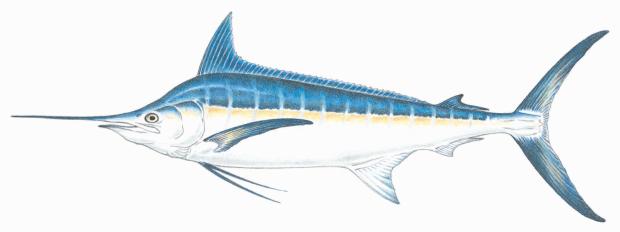Appearance
- Atlantic blue marlins can grow to be 14 feet long and weigh 2000 pounds. Females grow far larger than males.
- The fish is dark blue along the back which fades to silver on the sides and white on the belly.
- The Atlantic blue marlin has a long pointed bill, and a steep dorsal fin that runs along most of the body. It also has two long pelvic fins.
Atlantic blue marlin facts
- Species name: Makaira nigricans
- Atlantic blue marlin prey on squid and epipelagic fishes such as:
- Mackerel
- Tuna
- Dolphinfishes
- Young Atlantic blue marlin are preyed upon by other large pelagic predators. Adults are hunted by large sharks such as the white shark and shortfin mako shark.
- The breeding history of Atlantic blue marlin isn't well known. They spawn near Cuba between May and November, and hatch within a week of spawning.
- Marlin larvae have large eyes and pectoral fins. They don't form a bill until they are older.
- Atlantic blue marlin are highly migratory and stay in warm waters.
- Commercial fishing for Atlantic blue marlin is prohibited in the United States.
- Trolling with artificial lures is the most common way to catch blue marlin. You should use trolling rods and large conventional reels, as well as stronger monofilament line when catching blue marlin.
- Blue marlin is prized for sushi in Japan, but contains a high amount of mercury which can be harmful to humans.
- Blue marlin are found from Canada to Brazil in the Atlantic Ocean, and tropical waters worldwide.
Additional Resources
Contact
Online
DMF Staff Directory
Contact DMF staff
Fax
(508) 990-0449
Address
836 S Rodney French Blvd, New Bedford, MA 02744

